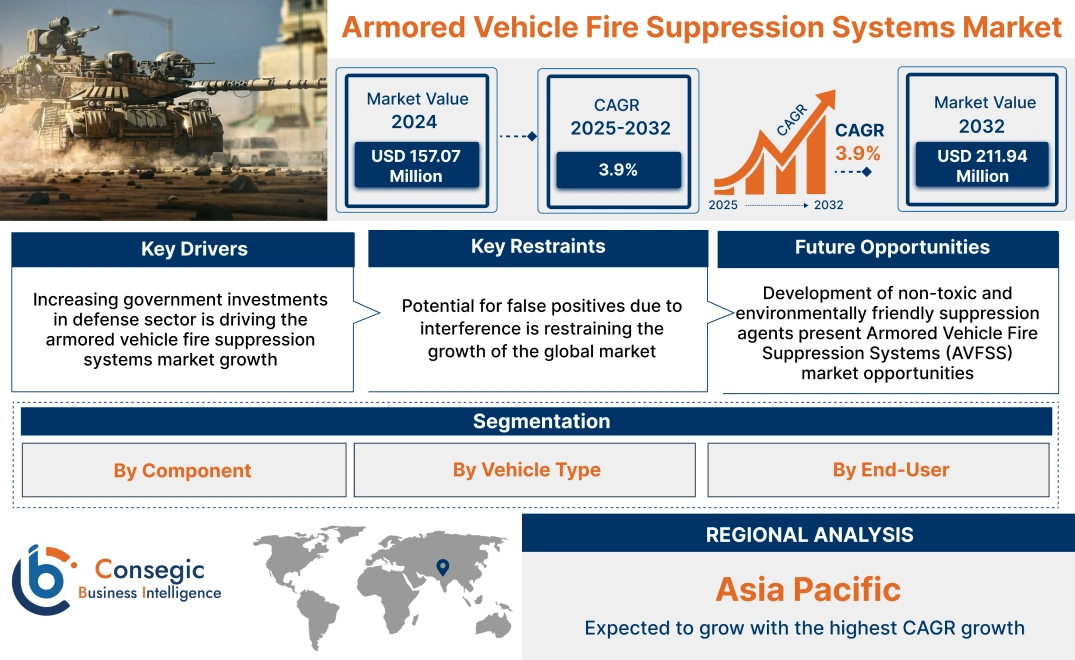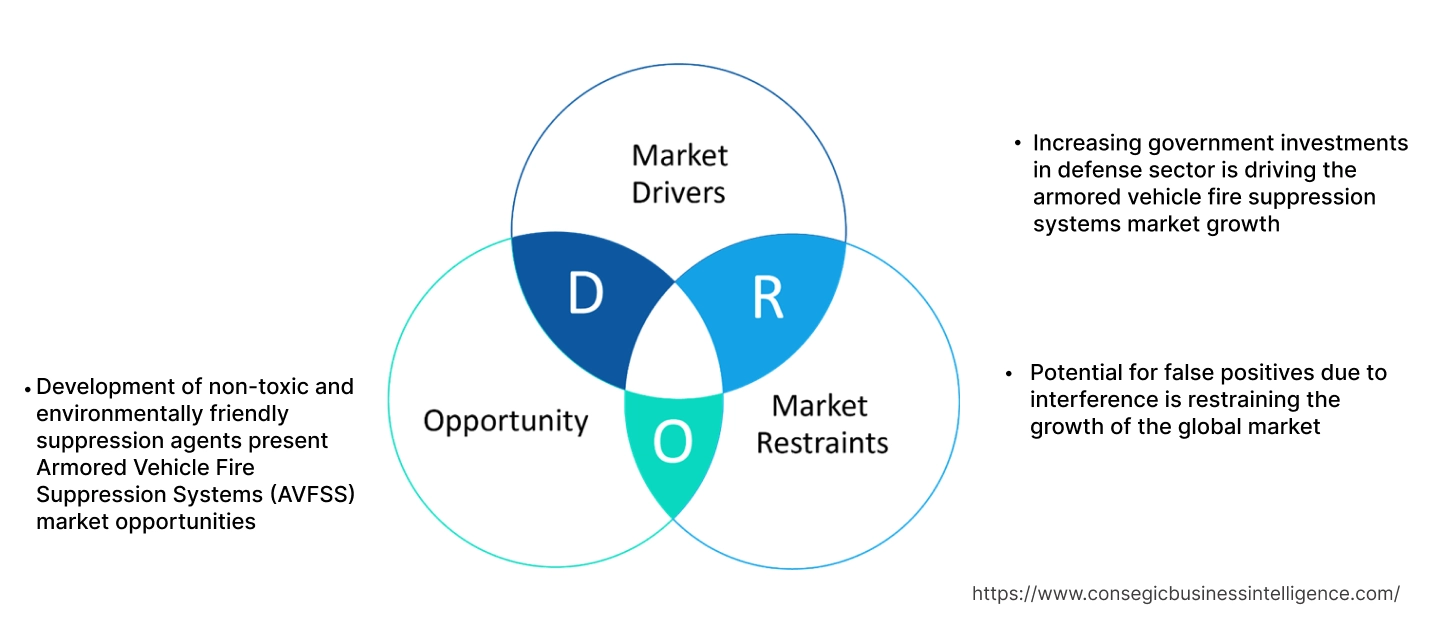- Summary
- Table Of Content
- Methodology
Armored Vehicle Fire Suppression Systems Market Size:
Armored Vehicle Fire Suppression Systems Market Size is estimated to reach over USD 211.94 Million by 2032 from a value of USD 157.07 Million in 2024 and is projected to grow by USD 162.00 Million in 2025, growing at a CAGR of 3.9% from 2025 to 2032.
Armored Vehicle Fire Suppression Systems Market Scope & Overview:
An armored vehicle fire suppression system is a safety mechanism designed to automatically extinguish fires within armored vehicles. These systems consist of fire detection sensors, a control panel, fire-suppressing agent tanks, and a distribution network of nozzles. When a fire is detected, the system automatically discharges a fire-suppressing agent, such as an aerosol or gas, to extinguish the flames and protect the crew and vehicle.
Key Drivers:
Increasing government investments in defense sector is driving the armored vehicle fire suppression systems market growth
Governments worldwide are increasing the defense budgets to upgrade their military capabilities and respond to evolving security threats. This substantial investment directly fuels the demand for Armored Vehicle Fire Suppression Systems (AVFSS) as a crucial component of vehicle safety and crew protection. Additionally, older armored vehicles also need to be upgraded with AVFSS as part of broader modernization programs and this retrofitting process further boosts the armored vehicle suppression systems market demand. Moreover, governments recognize the value of their military personnel and investing in safety features like AVFSS demonstrates a commitment to protecting human capital.
- For instance, in March 2023, UK released the 2023 Integrated Review Refresh, a document outlining the country's foreign policy and defense priorities in response to global instability. The review includes a £5 billion investment in defense over two years and sets an ambition to increase defense spending to 2.5% of GDP as fiscal and economic circumstances allow.
Thus, the increasing investments by the government in defense sector is driving the armored vehicle fire suppression systems market size.
Key Restraints:
Potential for false positives due to interference is restraining the growth of the global market
The systems are essential for detecting and warning pilots about lightning strikes to ensure aircraft safety. However, interference compromises the accuracy and reliability of these systems, leading to false alarms. Frequent false positives erode confidence in lightning detection systems, impeding market expansion. Additionally, false positives lead to unnecessary operational delays and cancellations, causing financial and logistical challenges for airlines. Moreover, addressing interference issues requires advanced signal processing technologies, increased R&D investment, and more sophisticated system designs. The higher cost deters adoption, particularly among cost-conscious customers, further limiting the advancement of the global armored vehicle fire suppression systems market.
Thus, as per the analysis, potential for false positives due to interference is impeding the armored vehicle fire suppression systems market growth.
Future Opportunities :
Development of non-toxic and environmentally friendly suppression agents present Armored Vehicle Fire Suppression Systems (AVFSS) market opportunities
Many countries have strict regulations regarding the use of fire suppression agents, particularly those that are harmful to the environment or human health. The development of eco-friendly agents ensures compliance with these regulations, thus expanding the reach of AVFSS manufacturers. Additionally, some traditional suppression agents leave residue that requires extensive cleaning and maintenance. Non-toxic and environmentally friendly agents are less likely to cause such damage, reducing maintenance costs and downtime for armored vehicles. Moreover, fire suppression systems also use inert gas to extinguish power and advanced valve technology to precisely control agent discharge, further contributing to the growth of armored vehicle fire suppression systems market share.
- For instance, Johnson Controls (Ansul), iFLOW 300 Bar leverages the power of inert gases to extinguish fires and incorporates valve technology to precisely control agent discharge, minimizing the size of pipes needed for distribution. By reducing oxygen levels below the point of combustion, it effectively suppresses fires in various hazard classes (A, B, and C) while ensuring a breathable atmosphere for occupants.
Hence, based on the analysis the development of non-toxic and environmentally friendly suppression agents is expected to create armored vehicle fire suppression systems market opportunities.
Armored Vehicle Fire Suppression Systems Market Segmental Analysis :
By Component:
Based on the component, the market is segmented into detectors, suppressants, control panels, and others.
Trends in the Component:
- Detectors are being integrated with other vehicle systems, such as engine control units and communication networks, to enable proactive fire prevention measures and facilitate faster response times.
- The shift from traditional agents like Halon, which deplete the ozone layer, has led to the development of eco-friendly alternatives such as Novec 1230, argon, and dry chemical agents.
The suppressants segment accounted for the largest revenue share in 2024
- Suppressants are the core component of armored vehicle fire suppression systems that directly extinguishes fires, minimizing damage and reducing the risk of injury or loss of life.
- Suppressants are designed to seamlessly integrate with other components of the fire suppression system, such as detection and activation mechanisms.
- The market offers various suppressants like dry chemical, gaseous agents, and foam, each with unique properties and applications, catering to different vehicle types and fire scenarios, thereby improving the armored vehicle fire suppression systems market share.
- For instance, FIRETRACE International’s, FM-200 (HFC-227ea) is a recognized clean agent fire suppressant that effectively extinguishes Class A, B, and C fires. It adheres to the rigorous safety standards outlined in NFPA 2001 and are safe for use in occupied areas and leave no residue behind after deployment.
- Thus, as per the analysis the growing adoption of suppressants to directly extinguish fire is driving the armored vehicle fire suppression systems market size.
The detectors segment is expected to register the highest CAGR over the forecast period
- Ongoing R&D in sensor technology is leading to the creation of more sensitive and accurate detectors. The development of optical, thermal, and acoustic sensors detect fires at earlier stages, allowing for quicker response times and potentially preventing catastrophic damage.
- Advanced armored vehicles are equipped with integrated systems that combine fire suppression with other safety features. Detectors are a key component of these systems, providing input to the overall fire suppression strategy and enabling a more coordinated response.
- The growing trend towards autonomous and remotely operated vehicles is also driving demand for advanced detectors. These vehicles operate in remote or hazardous environments, making early fire detection even more critical, thus driving the market size.
- Overall, the combination of technological advancements, integration with advanced systems, and the increasing adoption of autonomous and remotely operated vehicles is expected to drive significant growth in the detectors segment of the armored vehicle fire suppression systems market over the forecast period.
By Vehicle Type:
Based on the vehicle type, the market is segmented into Combat Vehicles, Troop Transport Vehicles, and Others.
Trends in the Vehicle type:
- Growing emphasis on equipping Main Battle Tanks (MBTs), Infantry Fighting Vehicles (IFVs), and Armoured Personnel Carriers (APCs) with advanced fire suppression systems due to rising threats in combat scenarios.
- The shift towards gas-based suppression agents is notable, as they are less corrosive and more effective in oxygen deprivation compared to traditional systems.
The Combat Vehicles segment dominated the target market for the largest revenue share of 71.36% in 2024 and are also projected to witness fastest CAGR in forecast period
- Combat vehicles represent significant investments in terms of research, development, and procurement, thus protecting these assets from fire damage is economically crucial.
- Combat vehicles, especially with powerful engines and ammunition storage, are more susceptible to fire hazards. Fires can be triggered by enemy attacks, accidental discharges, or mechanical malfunctions.
- Modern fire suppression systems are becoming more sophisticated, with features like early detection, automatic activation, and agent selection based on the type of fire and this increased effectiveness drives the market share.
- Also, the increase in the arms sales globally is also driving the market growth.
- For ins Armored Vehicle Fire Suppression Systems tance, the total value of S. arms sales in fiscal year 2022 reached approximately USD 52 billion, a significant increase of nearly 50% compared to the USD 34.81 billion recorded in fiscal year 2021.
- Thus, the aforementioned benefits are contributing significantly in driving the growth of combat vehicles segment during the forecast year.
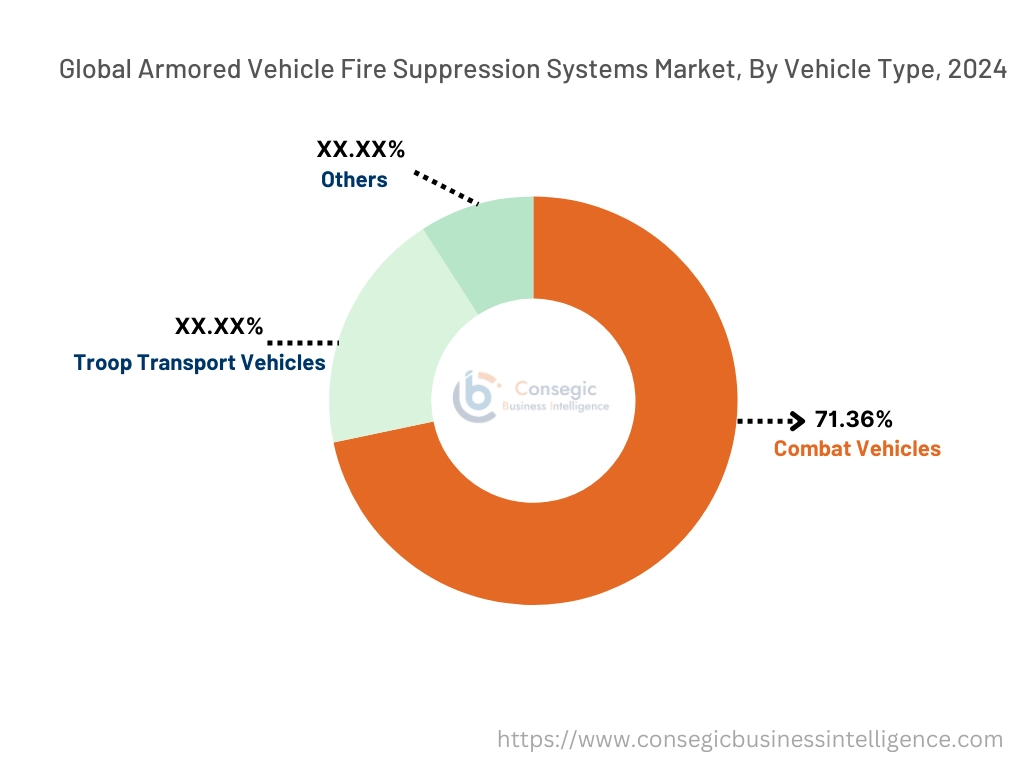
By End-User:
Based on the end user, the market is segmented into military and law enforcement
Trends in the End-User:
- Increasing defense budgets and the need for enhanced vehicle safety in combat scenarios.
- Law enforcement agencies are increasingly adopting these systems for tactical vehicles, reflecting a heightened awareness of fire safety in civilian operations.
Military accounted for the largest revenue share of in the year 2024 and is also projected to witness the fastest CAGR during the forecast period
- Fire suppression systems protects crew members from fires and provides rapid fire detection and suppression to minimize injury risk.
- Also, the system prevents total vehicle loss during combat or accidents and ensures the vehicle remain operational even after minor fire incidents.
- Moreover, the emergence of advanced technologies including AN (Controller Area Network) technology ensures efficient operation and maintenance.
- For instance, ExAct Titan Fire Suppression System boasts rapid fire detection and suppression capabilities and advanced CAN technology for reliable communication and control. These features translate into significant benefits, including enhanced crew safety by minimizing fire-related injuries and fatalities, reduced downtime and operational costs due to minimal maintenance requirements, and increased mission effectiveness by ensuring the continued operation of critical military vehicles and equipment.
- Thus, based on the armored vehicle fire suppression systems market analysis, integration of advanced technologies in military sector is driving the market progression.
Regional Analysis:
The global Armored Vehicle Fire Suppression Systems market has been classified by region into North America, Europe, Asia-Pacific, MEA, and Latin America.
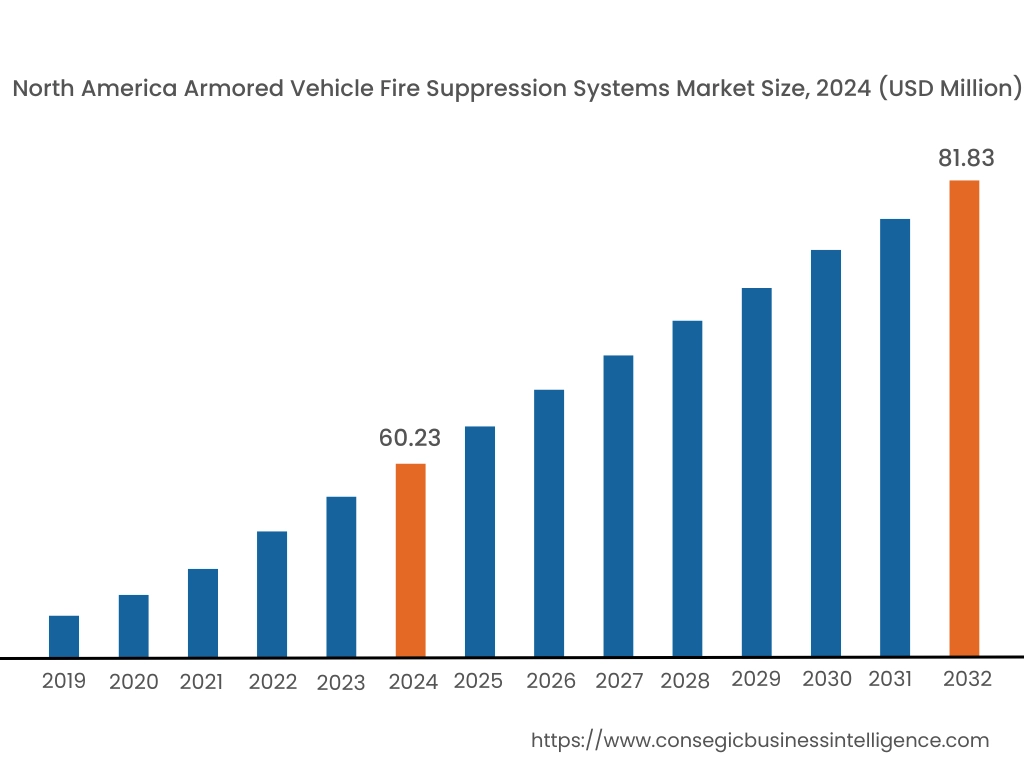
North America region was valued at USD 60.23 Million in 2024. Moreover, it is projected to grow by USD 62.16 Million in 2025 and reach over USD 81.83 Million by 2032. Out of these, U.S. accounted for the largest revenue share of 71.3% in 2024.
North America often has stricter safety regulations for military and commercial vehicles, including armored vehicles. This regulatory environment drives the adoption of advanced fire suppression systems to meet compliance standards. Additionally, North America, particularly the United States, has a powerful military with substantial investments in armored vehicles. The large fleet necessitates a corresponding demand for effective fire suppression systems to protect personnel and equipment, hence driving the armored vehicle fire suppression systems market expansion.
- For instance, the FY 2025 budget request allocates USD 143.2 billion for research, development, testing, and evaluation (RDT&E) in the United States, along with USD 167.5 billion for procurement. This significant investment aims to enhance the nation's military capabilities across all domains, leading to the establishment of stronger, more agile, and modern combat-credible forces.
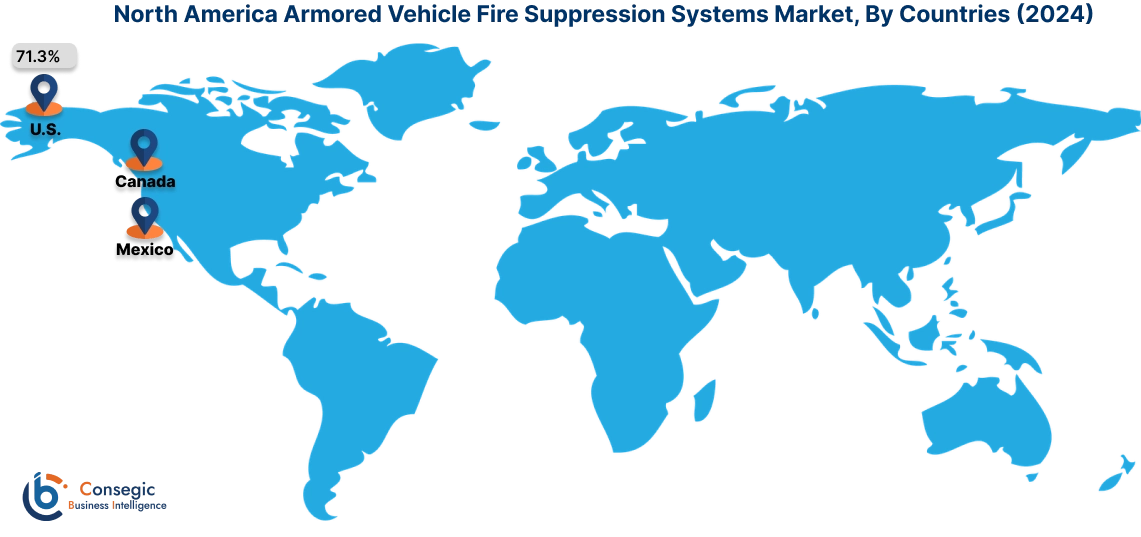
Asia Pacific region was valued at USD 44.85 Million in 2024. Moreover, it is projected to grow by USD 46.36 Million in 2025 and reach over USD 62.03 Million by 2032.
The region is marked by territorial disputes, border conflicts, and increasing defense spending. This necessitates the procurement of modern armored vehicles equipped with advanced safety features, including fire suppression systems. Additionally, many countries in the Asia Pacific are actively upgrading their militaries by replacing older equipment with newer, thus driving armored vehicle fire suppression systems market expansion. This includes the integration of fire suppression systems into armored vehicles as a standard safety measure. Moreover, the prevalence of urban warfare and counter-terrorism operations in the region is expected to increase the demand for maneuverable and well-protected armored vehicles. These vehicles require robust fire suppression systems to ensure crew safety in challenging environments, which in turn, is driving the market.
- For instance, the Taliban and ISIS-Khorasan are engaged in a violent conflict in Afghanistan. ISIS-Khorasan employ terrorist tactics, targeting both civilians and Taliban members leading to increased violence and instability in the region.
Consequently, the aforementioned factors are creating a favorable environment for the development of the armored vehicle fire suppression systems market in Asia Pacific. The region's strategic importance, coupled with its increasing defense spending and focus on development, is expected to drive significant demand for these systems in the coming years.
As per the armored vehicle fire suppression systems market analysis, European countries are investing heavily in modernizing their armed forces, including upgrading existing armored vehicles and acquiring new ones, necessitating the integration of advanced fire suppression systems. Additionally, the need to combat insurgency and terrorism is driving the demand for better-protected armored vehicles equipped with advanced fire suppression systems in Latin America. Furthermore, the expansion of the oil and gas industry in Middle East and Africa is creating armored vehicle fire suppression systems market demand for security and transportation purposes.
Top Key Players and Market Share Insights:
The market is highly competitive with major players providing casino management solutions to the national and international markets. Key players are adopting several strategies in research and development (R&D), product innovation, and end-user launches to hold a strong position in the market. Key players in the armored vehicle fire suppression systems industry include-
- Kidde-Deugra Brandschutzsysteme GmbH (Germany)
- N2 Towers Inc. (Canada)
- Fire Protection Technologies Pty Ltd. (Australia)
- Lifeline Fire and Safety Systems (United Kingdom)
- Spectrex (U.S.)
- Halma plc (United Kingdom)
- BEL|Bharat Electronics Limited (India)
- Marioff Corporation (Finland)
- Elbit Systems (Israel)
- Firetrace International (U.S.)
Recent Industry Developments :
Partnerships & Collaborations:
- In, May 2024, FNSS showcased the cutting-edge PARS III 6x6 armored vehicle at DSA 2024 Exhibition in Malaysia. This formidable platform is equipped with advanced weaponry, including the TEBER-II 30/40 Remote-Controlled Turret (RCT) and the SANCAK 30 mm RCT, offering enhanced combat capabilities. Furthermore, the PARS III 6x6 incorporates standard automatic fire suppression systems for enhanced crew safety.
- In February 2024, during WDS 2024 in Saudi Arabia, Otokar unveiled its Ural A Tactical Armored Vehicle. This vehicle is built to support a team of eight, consisting of two crew members and six infantry soldiers, and is particularly effective in reconnaissance, patrol, and assault operations. Designed for toughness, the Ural performs well in challenging environments and is equipped with advanced safety features, including an engine fire suppression system, which enhances its durability in combat situations.
Armored Vehicle Fire Suppression Systems Market Report Insights :
| Report Attributes | Report Details |
| Study Timeline | 2018-2032 |
| Market Size in 2032 | USD 211.94 Million |
| CAGR (2025-2032) | 3.9% |
| By Component |
|
| By Vehicle Type |
|
| By End-User |
|
| By Region |
|
| Key Players |
|
| North America | U.S. Canada Mexico |
| Europe | U.K. Germany France Spain Italy Russia Benelux Rest of Europe |
| APAC | China South Korea Japan India Australia ASEAN Rest of Asia-Pacific |
| Middle East and Africa | GCC Turkey South Africa Rest of MEA |
| LATAM | Brazil Argentina Chile Rest of LATAM |
| Report Coverage |
|
Key Questions Answered in the Report
How big is the Armored Vehicle Fire Suppression Systems market? +
The Armored Vehicle Fire Suppression Systems Market Size is estimated to reach over USD 211.94 Million by 2032 from a value of USD 157.07 Million in 2024 and is projected to grow by USD 162.00 Million in 2025, growing at a CAGR of 3.9% from 2025 to 2032.
What specific segmentation details are covered in the Armored Vehicle Fire Suppression Systems report? +
The Armored Vehicle Fire Suppression Systems report includes specific segmentation details for component, vehicle type, end user, and regions.
Which is the fastest segment anticipated to impact the market growth? +
In the armored vehicle fire suppression systems market, the detectors is the fastest-growing segment during the forecast period.
Who are the major players in the Armored Vehicle Fire Suppression Systems market? +
The key participants in the Armored Vehicle Fire Suppression Systems market are Kidde-Deugra Brandschutzsysteme GmbH (Germany), N2 Towers Inc. (Canada), Fire Protection Technologies Pty Ltd. (Australia), Lifeline Fire and Safety Systems (United Kingdom), Spectrex (U.S.), Halma plc (United Kingdom), BEL|Bharat Electronics Limited (India), Marioff Corporation (Finland), Elbit Systems (Israel), Firetrace International (U.S.), and others.
